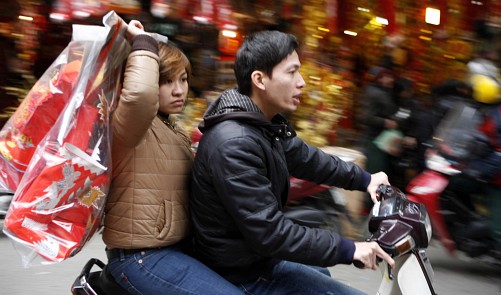Editor’s Note: Scott Duke Harris, our Hanoi-based columnist, responds to an April 9 article by an anonymous Australian who complained that Vietnamese are stuck in so-called “Tunnel Vision,” which only allows them to see what is directly in front of them, not anything behind or next to them.
HANOI – The other day I was riding in a crowded taxi, seated beside the driver. We eased to a stop on a busy street, our path blocked by the sedan with a clearly inexperienced driver making an awkward U-turn in front of us.
He had maneuvered around one of those slim concrete barriers, designed to prevent the kind of risky passing maneuvers common among Vietnamese motorists, and was blocking two lanes.
To my far right, I noticed a motorcyclist with one passenger move forward, hoping to slither past the sedan in the gutter against the beveled curb.
The driver of the car had paused, as if belatedly realizing he lacked space to make a U-turn and would have to back up a bit before proceeding forward. The motorcyclist seized the moment.
But then the sedan lurched forward – and the right front bumper smacked the motorcycle in the side, knocking it and its riders tumbling on to the sidewalk.
Both the driver of the car and the rider of the motorcycle seemed stunned, as if wondering how that could have happened. The good news was that nobody appeared seriously injured. The driver of the sedan backed up and then moved a few feet forward before stopping to check on the motorcyclist and his passenger.
This incident came to mind as I read a recent post in Tuoi Tre’s City Diary titled “Tunnel Vision” by an Australian who has lived in Vietnam for ten years but didn’t want his or her authorship known.
The anonymous Aussie suggested that “tunnel vision” on the road might be a metaphor for self-centered social behavior in general in Vietnam. Sometimes, I think, “tunnel vision” is just inexperience.
Still, there are certainly reasons to gripe. Because I spend most of my time in the capital, I sometimes classify certain people as “annoyin’ Hanoians.” These include jerks who drive too fast in residential areas, motorcyclists on cell phones and litterbugs. Why, I wonder, aren’t more Hanoians annoyed themselves by these annoyin’ Hanoians? How about a little civic pride? Vietnam’s manic motoring – a Darwinian struggle that pits adaptability against brute force – is the first culture shock for many newcomers.
In my first days in Vietnam, my son and I were frightened when at rush hour a herd of motorcycles suddenly roared up behind us on a sidewalk. A sidewalk!
Over the passing weeks, absorbing and contemplating the cognitive dissonance, it struck me as oddly ironic that a nation trying to unshackle itself from central economic planning had such a laissez-faire attitude about traffic.
When my children attended Hanoi International School, the school’s principal and staff formed a security gauntlet at the entrance in the morning to prevent motorcyclists from plowing into the children.
I now understand why motorcyclists sometimes use the sidewalks – but why do so many pedestrians prefer to walk on the street even when a sidewalk is available? Often these are companions walking side by side.
I respect the chutzpah – the attitude that they, as human beings, have as much right to that piece of asphalt as any car, motorbike or bicycle. If somebody honks, they tend to ignore it. Similarly, student bicyclists in my neighborhood often ride four or five abreast.
Having scootered around Hanoi for about three years – earning a few scrapes along the way, learning by harsh experience – I can now proudly claim to have used the sidewalk to negotiate a traffic jam or two. (When in Hanoi, do as the Hanoians do.)
I’ve had reason to drive against the flow of traffic a few times. I do regret, however, that time when I frightened that pedestrian who didn’t see me coming after I made a wrong turn. I could accuse her of “tunnel vision,” perhaps, but that seems unfair.
Annoyin’ Hanoians sometimes appear wherever there’s a queue. The other day, I took my place at the rear of a long line for movie tickets at a mall cinema. The queue stretched past the ropes strung to ensure first-come, first-served order.
Soon there were five or six other people behind me. As I approached the ropes, I noticed a man casually lurking. I eyeballed him, suspecting that he might sidle in if I became distracted. He noticed my stare, hesitated – and gestured me forward.
I wasn’t seeking permission, jerk. Get in line.
Speaking of the cinema in Vietnam, I admit to getting a guilty pleasure from that advertisement that mocks the crude rural folk who talks loudly on cellphones during a movie. That ad would be deemed rude and politically incorrect in the U.S., but such denigration is tolerated here.
I don’t want to overstate these matters, because there is, of course, rude behavior all over the world. Perhaps the episodes of aggressive, annoying actions or thoughtless “tunnel vision” stand out because it’s a contrast to the polite, gracious norm.
Still, more public service ads might be a good idea.
Topic for discussion: Is it hard to kick Vietnamese’s bad habits?
As an expat or a foreign tourist to Vietnam, have you ever noticed any bad habits of local people? What should and shouldn’t Vietnamese do in public areas? Please share your story with us by sending it to: ttn@tuoitre.com.vn.
























































